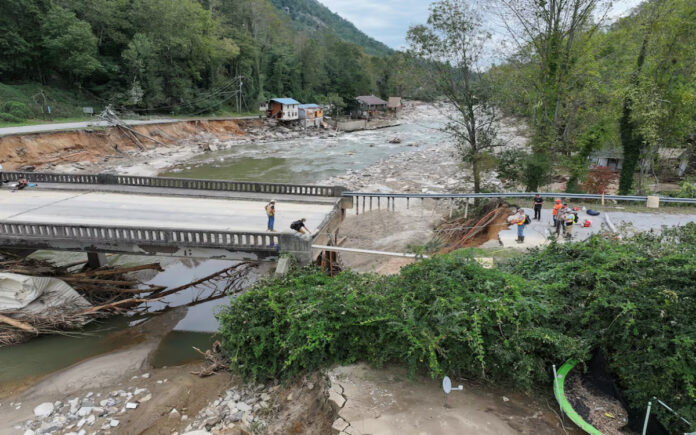Raleigh: Emergency crews began airlifting food and water into isolated North Carolina towns devastated by tropical storm Helene, which transformed the western part of the state into what many described as a “post-apocalyptic” landscape.
Initially a hurricane when it made landfall on the Florida Gulf coast on Thursday, Helene carved a path of destruction across southeastern states, uprooting roads, demolishing homes, and severing communication lines. In its aftermath, hundreds remain unaccounted for, and many are feared dead.
The storm’s death toll exceeds 100 across North Carolina, South Carolina, Georgia, Florida, Tennessee, and Virginia, with further increases expected as rescue teams reach remote areas and emergency communications are restored. In North Carolina alone, approximately 300 roads are closed, over 7,000 residents have registered for assistance from the U.S. Federal Emergency Management Agency (FEMA), and the National Guard is transporting 1,000 tons of food and water to affected regions via airlift.
Among the hardest-hit areas is Bat Cave, a small hamlet located about 100 miles (160 km) west of Charlotte. Climate scientists have categorized the unprecedented flooding of the Broad River as a “1,000-year event,” which has washed away homes and collapsed the town’s bridge.
In the wake of the storm, residents carefully crossed the bridge’s gap on precarious planks. Aaron Smith, 31, along with his wife and two young sons, sat in front of the Bat Cave fire station with only a single suitcase—everything they could salvage after the Hickory Creek surged, demolishing three walls of their home and sending a boulder crashing through a bedroom.
“There’s no roads, there’s no evidence of roads, there’s no trees, it’s just water and stuff,” Smith said. “When it comes to where we’re going to go from here, I guess anywhere but here. I don’t see anything to go back to.”
Efforts to evacuate residents using private helicopters faced challenges as locals warned pilots away from a bridge that appeared on the verge of collapse, with firefighters spray-painting “DON’T LAND” on the structure. Bat Cave lies just upstream from Chimney Rock, another village significantly impacted by the floodwaters, which poured into Lake Lure, now littered with debris from destroyed homes and trees.
Charlotte City Councilman Tariq Bokhari shared a video on X, showcasing the devastation at Lake Lure and describing it as “post-apocalyptic”. He reflected on the overwhelming nature of the destruction, stating, “You don’t even know how to fathom what recovery looks like, let alone where to start.”
Also Read | Biden to Maintain 125,000 Refugee Admissions Target for 2025
Government Response and Recovery Efforts
The U.S. government, along with state and local agencies, is engaged in a comprehensive recovery effort across the southeast. As of Monday, approximately 1.8 million homes and businesses were without power, according to Poweroutage.us.
Georgia Governor Brian Kemp reported at least 25 fatalities in his state, including a firefighter and a mother with her one-month-old twins who perished due to a falling tree. South Carolina has recorded at least 29 deaths, bringing the national toll to 128, according to CNN, with 56 casualties in North Carolina alone.
In Buncombe County, which encompasses the tourist destination of Asheville, 40 deaths have been confirmed, as stated by the county manager. North Carolina Governor Roy Cooper conducted an aerial survey of the damage and emphasized the need for “significant resources” for both short-term and long-term recovery.
“The devastation was beyond belief,” Cooper remarked. “Even when you prepare for something like this, this is something that’s never happened before in western North Carolina. Search and rescue teams are continuing to work.”
Also Read | Israel Launches Ground Invasion, Targets Hezbollah in Southern Lebanon
Approximately 1,200 federal personnel are currently on the ground, alongside state and local responders, and the U.S. Army Corps of Engineers is organizing major debris removal operations. FEMA Administrator Deanne Criswell noted that about 3,000 federal personnel have been deployed throughout the region.
President Joe Biden, linking the storm’s destruction to climate change, plans to visit North Carolina on Wednesday and will soon travel to Georgia and Florida. He may also request Congress to return for a special session to approve supplemental aid funding.
“There’s nothing like wondering, ‘Is my husband, wife, son, daughter, mother, father alive?'” Biden stated at the White House. “Many more will remain without electricity, water, food, and communications, and whose homes and businesses are washed away in an instant. I want them to know we’re not leaving until the job is done.”



